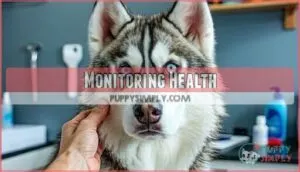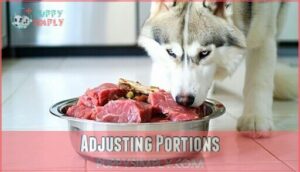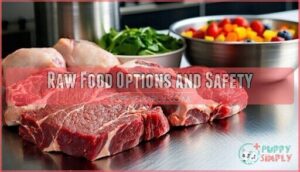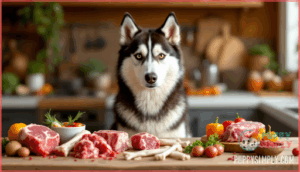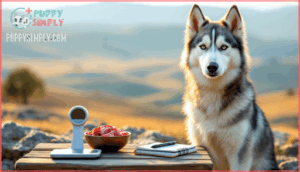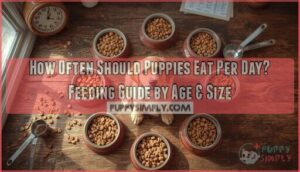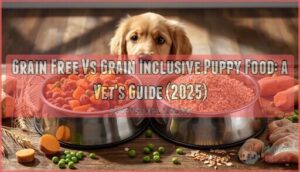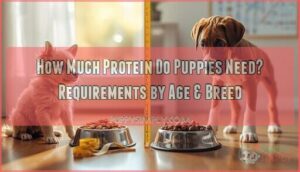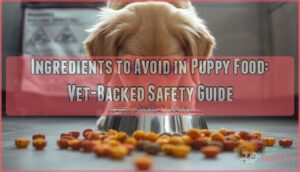This site is supported by our readers. We may earn a commission, at no cost to you, if you purchase through links.
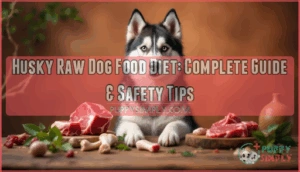
However, you’ll need to carefully balance nutrients—typically 80% muscle meat, 10% bone, and 10% organs—while maintaining proper protein levels of 18-25% for adults. Raw feeding requires strict food safety practices to prevent bacterial contamination and gradual shift to avoid digestive upset.
Monthly costs range from $75-$250, but many owners find fewer vet bills offset the expense. Understanding proper ratios and safety protocols makes all the difference between success and setbacks.
Table Of Contents
- Key Takeaways
- Benefits of Raw Diet
- Raw Diet Risks and Precautions
- Balanced Raw Diet Guidelines
- Creating a Raw Diet Plan
- Transitioning to Raw Diet
- Raw Food Options and Safety
- Nutritional Balance and Needs
- Common Mistakes to Avoid
- Raw Diet Costs and Comparison
- Monitoring Health and Adjusting
- Frequently Asked Questions (FAQs)
- How do I safely handle and prepare raw food for my husky?
- How do I transition my husky from a kibble diet to a raw diet?
- Can puppies eat raw food safely?
- How often should I feed raw meals?
- What equipment do I need for preparation?
- Can I mix raw and kibble together?
- How do I travel with raw food?
- How much raw food per day?
- What about traveling with raw diet?
- Should I feed raw year-round?
- Conclusion
Key Takeaways
- You’ll need to follow the 80-10-10 formula strictly—80% muscle meat, 10% raw bones, and 10% organs—to prevent nutritional imbalances that can cause serious health issues like rickets or organ dysfunction.
- You must practice strict food safety protocols since raw meat carries dangerous bacteria like Salmonella (21-35% contamination rate) and E. coli (46% contamination rate) that can harm both you and your dog.
- You should expect to spend $75-250 monthly on raw food, but many owners report reduced vet bills from fewer allergies, better digestion, and improved overall health that offset the higher upfront costs.
- You’ll want to transition gradually over four weeks while monitoring your husky’s weight, energy levels, and stool quality, since sudden dietary changes can cause digestive upset and other complications.
Benefits of Raw Diet
You’ll discover that switching your Husky to a raw diet can transform their health in remarkable ways, from shinier coats to better digestion.
The benefits aren’t just cosmetic – many owners report their dogs have more energy and fewer allergy problems after making the change, which can lead to a significant improvement in their overall health.
Improved Digestion
Switching to a raw dog food diet often transforms your husky’s digestive health dramatically.
Raw feeding promotes gut health through natural digestive enzymes that processed kibble destroys during manufacturing.
Natural enzymes in raw food unlock better digestion than processed alternatives
You’ll notice improved stool quality within weeks—firmer, smaller, and less odorous.
This intestinal balance occurs because raw diets support better nutrient absorption, reducing digestive strain and inflammation commonly seen with grain-heavy commercial foods.
The transformation is largely due to the fact that raw diets support better health overall, and by extension, digestive health.
Healthier Skin and Coat
Raw dog food delivers remarkable skin and coat improvements you’ll notice within weeks.
Your husky’s coat gains a healthy glow from omega-3 and omega-6 fatty acids that commercial kibble often lacks.
Your husky’s transformation includes:
- Shiny coat that catches sunlight like silk
- Reduced shedding means less fur on your furniture
- Softer texture you’ll love running your fingers through
- Healthier skin with fewer hot spots and irritation.
The husky raw diet provides essential nutrients for superior fur care naturally.
Increased Energy Levels
Boosting your husky’s vitality through raw feeding delivers remarkable energy levels that’ll transform daily walks into power-packed adventures.
This high-quality dog food approach provides omega-3 fatty acids and easily digestible proteins that fuel sustained stamina throughout the day.
| Energy Boosters | Benefits |
|---|---|
| Raw meat proteins | Enhanced muscle development and endurance |
| Omega-3 fatty acids | Improved cardiovascular health and stamina |
| Natural enzymes | Better nutrient absorption and metabolism |
| Minimal processing | Higher bioavailability of energy sources |
| Balanced nutrition | Sustained energy without crashes |
These dietary changes create noticeable vitality improvements within weeks of switching to raw feeding husky protocols, resulting in remarkable energy levels and sustained stamina.
Reduced Allergy Symptoms
Beyond boosting energy, raw feeding offers impressive relief for allergy-prone Huskies.
Studies show fewer ear infections and reduced skin irritation in dogs switched to raw diets.
Four Key Allergy Prevention Benefits:
- Eliminates common kibble allergens – corn, wheat, and artificial additives that trigger reactions
- Reduces inflammatory responses – natural anti-inflammatory properties in raw meat calm irritated systems
- Strengthens immune function – better nutrient absorption supports your dog’s natural defenses
- Improves gut health – balanced bacteria reduce food sensitivity development
Raw diet benefits extend to managing existing symptoms while preventing new sensitivities from developing.
Raw Diet Risks and Precautions
While raw diets offer significant benefits for huskies, you’ll need to navigate several important risks to keep your dog safe and healthy.
Understanding bacterial contamination, choking hazards, nutritional imbalances, and potential allergic reactions helps you make informed decisions about your husky’s feeding plan, considering the significant benefits.
Bacterial Contamination
Bacterial contamination poses serious risks when you’re handling raw dog food.
Handle raw meat like it could poison your family—because it can
Raw meat carries dangerous bacteria that can make both you and your dog seriously ill.
Studies show Salmonella contamination affects 21-35% of commercial raw products, while E. coli appears in 46% of samples.
Proper food safety practices like thorough hand washing, stainless steel bowls, and immediate cleanup help reduce pathogen control risks, though contamination prevention requires constant vigilance during raw food handling.
Choking Hazards
Whole bones pose serious choking risks for your husky.
Large bone fragments can lodge in your dog’s throat, causing airway obstruction that requires emergency intervention.
Raw bones splinter differently than cooked bones, but both create food blocks that can trigger intestinal blockages.
Always supervise bone consumption and choose appropriately sized bones for huskies to minimize raw meat hazards.
Nutritional Imbalances
When you’re flying blind with homemade raw diets, you’re walking a nutritional tightrope.
Unbalanced diet compositions create serious malnutrition risks and dietary deficits that often go unnoticed for months.
Without proper planning, your husky faces nutrient gaps, mineral imbalance, and vitamin deficiency that compromise canine nutritional needs.
Raw diet risks include rickets from calcium shortages and organ dysfunction from poorly balanced meals affecting husky nutrition.
Allergic Reactions
Unlike broader nutritional problems, food allergies can trigger immediate and visible reactions in your husky.
You’ll notice skin issues like itching, redness, or hot spots within hours of feeding problematic ingredients.
Common culprits include beef, chicken, or fish proteins.
Watch for reaction symptoms like excessive scratching, ear infections, or digestive upset.
The immune response varies between dogs, making allergy tests helpful for identifying specific triggers and creating hypoallergenic diets.
Balanced Raw Diet Guidelines
Creating balanced raw diet guidelines for your husky requires precise nutritional ratios to meet their unique needs.
You’ll need to understand specific protein, fat, mineral, and vitamin requirements to keep your active companion healthy and thriving.
Protein Requirements
Your husky needs 18-25% protein for ideal health, with active dogs requiring up to 30%.
Adult huskies thrive on lean meats like chicken, beef, and turkey that provide complete amino acid profiles.
Muscle meat should form your protein foundation, while organ meats deliver concentrated nutrients.
Rotate protein sources to prevent deficiencies and maintain nutrient balance throughout your raw feeding journey.
Fat Recommendations
After establishing protein needs, fat intake becomes equally important for your husky’s raw diet success. Adult huskies need 5.5% dry matter fat, while puppies and pregnant dogs require 8.5%. Quality fat sources provide essential fatty acids your dog can’t produce naturally.
Here are three key fat considerations:
- Omega-3 sources – Fish oil or fatty fish like salmon support coat health and reduce inflammation
- Omega-6 balance – Found in poultry fat and plant oils, but shouldn’t exceed omega-3 ratios
- Natural fat content – Muscle meat and organ tissues provide species-appropriate fatty acid profiles
Proper nutrient ratio planning guarantees your husky gets balanced omega-3 and omega-6 fatty acids. High-quality dog food often lacks adequate omega-3, making supplementation vital for healthy health.
Mineral Sources
Your husky needs proper mineral sources for bone health and nutrient absorption.
Raw bones provide calcium naturally, while muscle meats supply phosphorus for mineral balance.
Include organ meats like spleen and pancreas for zinc and other minerals.
Sweet potatoes, seaweed, and eggshells offer additional dietary calcium.
Consider raw supplements if your homemade diet lacks variety.
Vitamin Needs
Your husky’s body can’t manufacture vitamins and minerals on its own, so you’ll need to provide them through food or supplements.
Raw diets may lack vitamins E and D without proper rotation or supplementation.
Essential nutrients like amino acids and omega3 fatty acids support immune function and coat health.
Monitor for vitamin deficiency signs and maintain proper nutrient balance to prevent health issues.
Creating a Raw Diet Plan
Creating a proper raw diet plan for your Husky requires balancing specific ratios of meat, bones, organs, and supplements to meet their nutritional needs.
You’ll need to carefully measure portions and rotate protein sources to guarantee your dog gets complete nutrition while avoiding deficiencies that could harm their health.
Meat and Bone Ratio
Getting your raw meat diet proportions right is like following a recipe—precision matters.
The golden standard for raw feeding guidelines follows the 80:10:10 rule: 80% muscle meat, 10% raw edible bone, and 10% organs.
This prey model diet ratio guarantees proper nutrient balance while maintaining ideal bone density for your husky’s health.
Organ Meat Inclusion
Organ meats pack serious nutritional punch for your husky’s raw diet.
You’ll want liver to make up 5% of the total diet, while other organs like kidney, heart, and spleen fill the remaining 5%.
This organ ratio guarantees your pup gets essential nutrients like iron, B vitamins, and essential amino acids.
Rotate different organ meats weekly for ideal nutrient balance and meat variety.
Fruit and Vegetable Addition
Adding fresh produce to your balanced raw diet gives your husky essential nutrients that meat and organs can’t provide alone.
Include 10% vegetables and fruits like carrots, spinach, blueberries, and apples in your veggie mix.
Raw greens offer a nutrient boost, but remember that dogs digest raw vegetables poorly, so lightly steam or puree them for better absorption and improved canine nutrition.
Supplement Consideration
While fruits and vegetables provide valuable nutrients, your husky may need additional supplements for ideal health.
Consider omega supplements for coat shine and joint care products containing glucosamine. Probiotic use supports digestive balance, while vitamin needs vary by individual dog.
A mineral boost through kelp or bone meal helps maintain nutritional balance in raw diet supplements. When selecting supplements, understanding omega benefits is vital for making informed decisions about your husky’s diet.
Transitioning to Raw Diet
Making the switch to raw food requires a gradual approach to prevent digestive upset and guarantee your husky adapts successfully.
You’ll need to monitor your dog’s response closely and be prepared to adjust portions or handle any temporary setbacks during this important adjustment period.
Monitoring Health
Watch your husky closely during the first weeks of raw feeding to catch any health changes early.
Regular Health Checks help you spot potential issues before they become serious problems.
- Monitor stool consistency and frequency for signs of digestive upset
- Track energy levels and appetite changes that indicate Diet Adjustments needed
- Observe skin, coat condition, and weight for overall Wellness Tracking progress
Adjusting Portions
Once you’ve watched your husky’s health responses, fine-tune their portion control based on their individual needs.
Feed huskies 2-4% of their ideal body weight daily, adjusting for activity level and metabolism. A 50-pound active husky typically needs 1-2 pounds of food daily.
Monitor weight weekly and adjust portions accordingly. Split meals into two feeding sessions to improve digestion and maintain a consistent feeding schedule for maximum nutrient balance.
Ensuring a proper raw food diet is vital for their overall health and development.
Handling Setbacks
Setbacks aren’t roadblocks—they’re learning opportunities that help you refine your husky’s raw diet shift.
When digestive problems or health crises emerge, don’t panic about diet failure.
Here’s your setback action plan:
- Return to previous week’s food ratio immediately
- Monitor for bacterial infections or feeding errors
- Document symptoms to identify raw mistakes patterns
- Consult your vet about dog health risks
- Review dog food safety standards before resuming
Raw Food Options and Safety
Choosing the right raw food options for your husky requires careful attention to safety and quality standards.
You’ll need to focus on proper meat selection, safe handling practices, contamination prevention, and close supervision during feeding times to ensure your husky’s health and well-being.
Meat and Bone Selection
Quality meat choices form the foundation of your husky’s raw dog food diet.
Select human-grade beef, chicken, turkey, and lamb from reputable sources.
Choose marrow bones and raw cuts with varied textures for dental health.
Include organ meats like liver and heart weekly.
Avoid cooked bones entirely—they splinter dangerously.
Your prey model raw approach needs diverse protein sources for maximal nutrition.
A balanced raw dog food diet requires understanding of raw food options to guarantee complete nutrition for your husky.
Handling and Storage
Once you’ve selected quality meats, proper handling and storage become your next priority.
Raw ingredients require careful attention to prevent bacterial growth and maintain nutritional value.
Follow these Storage Tips for essential food safety:
- Freezing Guidelines: Freeze pork and salmon for two weeks minimum to eliminate parasites before feeding
- Defrosting Methods: Thaw frozen meats in the refrigerator, never at room temperature where bacteria multiply rapidly
- Handling Precautions: Wash hands thoroughly after touching raw ingredients and clean all surfaces with disinfectant
Store raw dog food in sealed containers in your freezer or refrigerator. Label packages with dates to track freshness and rotation. Proper handling is vital for a safe raw dog food diet.
Avoiding Contamination
You’ll cut bacterial contamination risks dramatically by using separate cutting boards and utensils for raw meat preparation.
Clean all surfaces with bleach solution after each meal prep session to eliminate 99.9% of harmful bacteria like E coli and Campylobacter.
Always wash your hands for twenty seconds minimum after handling raw ingredients to prevent crosscontamination.
Supervising Consumption
Watch your husky closely during meals to prevent choking hazards and guarantee proper food intake.
Monitor their eating habits and consumption rate – some dogs gulp food too quickly, increasing risks.
Establish a consistent feeding schedule with appropriate meal portions, and stay nearby to intervene if needed, especially with bones or large pieces that could cause problems, to ensure proper food intake.
Nutritional Balance and Needs
Getting your Husky’s nutritional balance right isn’t just important—it’s essential for preventing serious health issues like rickets or organ dysfunction.
You’ll need to master the precise ratios of proteins, fats, minerals, and vitamins that keep your energetic companion thriving on their raw diet.
Vitamin and Mineral Balance
Your dog’s mineral balance acts like a nutritional tightrope walk.
Calcium needs must maintain a 1.2:1 ratio with phosphorus to prevent skeletal issues.
While omega balance from fish oil supports coat health.
Vitamin supplements become necessary when organ meats can’t meet B-vitamin requirements.
Mineral deficiency shows up as brittle coats or poor growth, making balanced diet planning critical for canine dietary needs and ideal dog nutrition.
Protein and Fat Requirements
Your husky needs adequate protein sources and fat content to thrive on a raw diet.
Adult huskies require 18% protein, while puppies need 22.5% for proper growth.
Animal proteins from beef, chicken, and turkey provide complete amino acids.
Fat should comprise 5.5% for adults and 8.5% for growing dogs.
This nutrient ratio supports your husky’s high energy needs and maintains ideal dietary balance through careful meal planning.
Additionally, understanding dietary supplement benefits can help inform decisions about adding supplements to your husky’s diet, considering their dietary balance.
Calcium and Phosphorus Ratio
Getting your calcium-phosphorus balance right prevents skeletal disorders and supports bone health in your husky’s raw food diet.
Your husky diet plan needs a 1.2:1 calcium-phosphorus ratio for ideal mineral balance. Raw bones naturally provide calcium needs, while muscle meat supplies phosphorus levels.
This nutrient ratio guarantees balanced dog nutrition and maximizes raw food benefits for your husky health.
Omega-3 Fatty Acid Needs
Your husky’s omega-3 fatty acid needs go beyond basic nutrition.
Fish oil supplements provide essential omega-3s that support joint health and reduce inflammation.
Raw dog food brands often lack adequate omega-3 levels, making supplementation necessary.
Aim for 100 mg per kilogram of body weight daily, and balance omega-3 with omega-6 ratios for ideal canine nutrition benefits.
Fatty acid deficiency shows through dull coats and joint stiffness, emphasizing the importance of proper omega-3 intake for overall health and well-being, including the need to reduce inflammation.
Common Mistakes to Avoid
Even experienced pet owners can make serious errors when switching to raw feeding that put their husky’s health at risk.
You’ll want to avoid these four critical mistakes that could lead to malnutrition, contamination, or digestive problems.
Imbalanced Diet
Throwing together random meat and bones without proper ratios creates a nutritional nightmare for your husky.
An imbalanced diet leads to serious nutrient deficiency and malnutrition risks that develop slowly over months.
Raw diet risks multiply when you skip the essential 80/10/10 formula or ignore organ meat requirements, causing skeletal disorders, immune problems, and digestive issues that expensive vet bills can’t always fix.
Inadequate Supplements
Many dog owners unknowingly create Vitamin Deficits and Nutrient Gaps when switching to raw diets without proper supplementation.
You can’t just throw meat in a bowl and call it balanced—your husky needs specific raw diet supplements to prevent Mineral Shortage and Dietary Imbalances.
Supplement Errors lead to serious dog nutritional deficiencies, so consult veterinary nutrition advice before supplementing dog diet plans.
Insufficient Hydration
Overlooking hydration needs can spell trouble for your Husky’s raw diet success. Raw food contains more moisture than kibble, but you’ll still need to monitor water intake closely.
Watch for dehydration signs like sticky gums or lethargy. Provide fresh water sources daily and consider electrolyte balance during active periods.
Poor Food Handling
Poor handling practices open the door to bacterial contamination and cross-contamination risks during raw feeding preparation.
You’ll need proper storage, safe thawing methods, thorough hand washing, and surface sanitation to protect your husky from dog food pathogens.
Don’t let sloppy hygiene turn your dog’s healthy meal into a health hazard requiring careful dog food safety protocols.
Raw Diet Costs and Comparison
You’ll want to understand the true cost of feeding your husky a raw diet before making the switch.
While raw food typically costs more upfront than kibble, the long-term health benefits can reduce veterinary expenses and provide better value for your investment.
Cost of Raw Food
Feeding your husky a raw diet costs substantially more than traditional kibble but offers potential health benefits.
Most owners spend $100-250 monthly on commercial raw foods, while DIY raw savings can reduce expenses to $75-120 per month through bulk buying options and careful sourcing.
Understanding raw food costs is essential for making informed decisions about your husky’s diet.
| Cost Factor | Monthly Range |
|---|---|
| Commercial Raw Diet | $100-250 |
| DIY Raw Diet | $75-120 |
| Premium Kibble | $40-60 |
| Bulk Buying Savings | 15-40% reduction |
| High-Activity Huskies | 10-25% increase |
Comparison to Kibble
Choosing between kibble and raw food transforms your husky’s mealtime from mundane to meaningful.
While kibble offers convenience, raw diets provide superior raw food digestion and nutrient absorption that commercial dog food simply can’t match.
| Aspect | Kibble | Raw Diet |
|---|---|---|
| Cost per pound | $1.97-$3.47 | $1.28-$6.40 |
| Digestion | Slower processing | Enhanced absorption |
| Nutrient density | Heat-processed | Bioavailable vitamins |
| Convenience | Grab-and-go | Prep required |
| Shelf stability | Long-term storage | Fresh preparation |
Budgeting for Raw Diet
Within the domain of raw feeding, smart budgeting transforms costly decisions into manageable investments.
You’ll need strategic planning to balance quality with affordability while maintaining your husky’s nutritional needs.
| Cost Category | Monthly Budget | Savings Tips |
|---|---|---|
| Meat & Organs | $80-120 | Buy in bulk, freeze portions |
| Bones & Supplements | $20-35 | Source locally, rotate proteins |
| Storage & Equipment | $15-25 | Invest in freezer space early |
Track your raw diet cost against previous dog food expenses to identify real savings opportunities and adjust your feeding economics accordingly, using strategic planning to make informed decisions.
Long-term Cost Benefits
While raw food requires higher upfront costs, you’ll likely see significant cost savings over time through reduced veterinary bills and improved health outcomes.
Financial benefits compound as your husky experiences fewer digestive issues, allergies, and dental problems that typically require expensive treatments.
| Traditional Kibble Costs | Raw Diet Investment |
|---|---|
| $1.97-$3.47 per pound | $3.90-$6.40 per pound |
| Higher vet bills for allergies | Reduced allergy treatments |
| Frequent dental cleanings | Natural dental maintenance |
| Digestive issue medications | Improved gut health |
| Lower long term value | Higher diet affordability return |
Smart budget planning recognizes that time investment for raw diet pays dividends through healthier, more energetic dogs requiring fewer medical interventions.
Monitoring Health and Adjusting
You’ll need to watch your husky closely during the first few months on raw food to catch any health changes early.
Regular weight checks and vet visits help you fine-tune portions and nutrients to keep your dog thriving on their new diet, ensuring you can make adjustments as needed to support their overall health and well-being.
Weight Management
Successful weight management hinges on calorie control and consistent monitoring of your husky’s body condition.
You’ll need to adjust portion sizes based on your dog’s activity level, age, and metabolism to prevent obesity and maintain ideal health.
- Monitor body condition monthly – Feel for ribs easily under light pressure, visible waist tuck
- Adjust feeding frequency – Split daily portions into 2-3 meals for better digestion
- Track weight weekly – Use consistent timing and scale for accurate measurements
- Watch for overweight signs – Difficulty feeling ribs, loss of waist definition, reduced energy
- Modify portions seasonally – Increase calories in winter, reduce during less active periods
Health Check-ups
Regular vet visits keep your husky’s raw diet on track.
Schedule wellness screens every 6-12 months for thorough dog exams, including blood work and stool testing.
Your veterinary nutritionist can catch nutritional imbalances early through targeted health tests, these medical checks monitor organ function and detect parasites that raw feeding might introduce.
Maintaining good dog health habits is essential for preventing diseases and ensuring a long, healthy life for your husky, with regular checks and balanced diet being crucial, and a healthy life as the ultimate goal.
Adjusting Diet as Needed
Most huskies need dietary adjustments throughout their lives based on changing health needs and activity levels.
Smart Diet Tweaks keep your furry athlete thriving as seasons and life stages shift.
- Weight Monitoring – Adjust portions when you notice weight changes during Health Checks
- Feeding Adjustments – Modify protein ratios for active versus sedentary periods
- Nutrient Balance – Add supplements if energy levels drop or coat quality declines
- Seasonal Changes – Increase calories during winter months for working huskies
Seeking Professional Advice
Don’t go it alone when making major dietary changes for your husky.
Vet consultation provides the foundation for safe raw feeding, while canine nutritional experts offer specialized diet planning customized to your dog’s needs.
Professional guidance through health screening helps you confirm you’re not missing underlying conditions that could complicate raw feeding.
Expert veterinary advice helps you navigate the nuances of balanced nutrition effectively.
Frequently Asked Questions (FAQs)
How do I safely handle and prepare raw food for my husky?
One wrong move with raw meat can turn dinner into disaster.
You’ll want to wash hands thoroughly, use separate cutting boards, freeze meat for two weeks to kill parasites, and refrigerate prepared portions immediately.
How do I transition my husky from a kibble diet to a raw diet?
Gradually phase over four weeks by mixing increasing amounts of raw food with decreasing kibble portions. Start with 75% kibble and 25% raw, then shift weekly ratios until you’re feeding 100% raw.
Can puppies eat raw food safely?
Puppies can eat raw food safely with proper precautions. You’ll need higher protein content (5% dry matter) and careful nutritional balance. Consult your veterinarian first, especially for very young pups.
How often should I feed raw meals?
Feed adult Huskies raw meals twice daily, spacing them 8-12 hours apart. Puppies need three to four smaller meals throughout the day for proper growth and digestion.
What equipment do I need for preparation?
You’ll need a meat grinder, sharp knives, cutting boards (separate for meat/vegetables), kitchen scale, freezer space, and storage containers.
Consider investing in bone grinders for larger bones and portion-control tools.
Can I mix raw and kibble together?
Mixing raw and kibble isn’t recommended because they digest at different rates, potentially causing stomach upset.
If you must combine them, feed separately with several hours between meals for better digestion.
How do I travel with raw food?
Approximately 32% of pet owners struggle with raw food storage during travel. You’ll need insulated coolers with ice packs, frozen portions that thaw gradually, and backup commercial raw options for extended trips.
How much raw food per day?
Your Husky should eat 2-4% of their ideal body weight daily in raw food. A 50-pound dog needs roughly 1-2 pounds per day, adjusted for activity level and metabolism.
What about traveling with raw diet?
Traveling with raw food requires advanced planning since you’ll need freezer space and proper storage. Pack frozen portions in insulated coolers with ice packs for short trips.
Should I feed raw year-round?
Can consistency be your superpower? Yes, you should feed raw year-round for maximum benefits.
Raw diets provide consistent nutrition that supports your husky’s health through all seasons, maintaining digestive balance and energy levels effectively, which can be considered your superpower.
Conclusion
Sure, your dog’s definitely judging your kibble choices from across the room. A successful husky raw dog food diet requires careful planning, proper ratios, and strict safety protocols. You’ll need to balance the 80-10-10 formula while monitoring your husky’s health closely.
Though initial costs seem high, many owners report reduced vet bills and healthier dogs. Start slowly, consult your veterinarian, and prioritize food safety throughout the conversion process. A successful husky raw dog food diet requires attention to these details to ensure the best outcomes for your pet.




